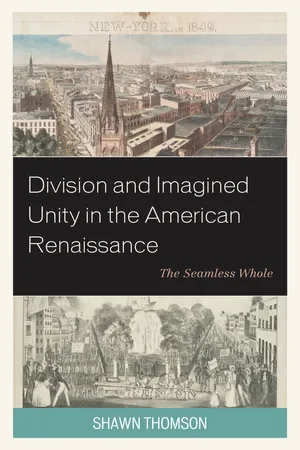
- English
- ePUB (mobile friendly)
- Available on iOS & Android
eBook - ePub
About this book
In examining the era's multivalent tropes of seams and seamlessness, Thomson provides an innovative understanding of the interplay between division and unity in the thought, culture, and literature of the American Renaissance. New insights are offered on works by major authors such as Nathaniel Hawthorne, Frederick Douglass, Walt Whitman, Herman Melville, Emily Dickinson, Henry David Thoreau, Solomon Northup, Harriet Jacobs, and Elizabeth Stoddard, along with marginal figures. Thomson expands the canon by recovering the unknown authors Charles Edward Anthon and John S. Sauzade and recognizing their works as vital to the American Renaissance.
Taking the 1844 display of the Holy Tunic at the Cathedral of Treves as its point of departure, Thomson sheds light on the controversy of the seamless garment in the New England press and explores its transmutation in Anthon's Pilgrimage to Treves, Hawthorne's The Scarlet Letter, Dickinson's poetry, and Melville's major novels. In excavating seamlessness as a cultural artifact of the American Renaissance, Thomson pursues a cultural studies approach to the fabric of antebellum life. Thomson reads the seams of material culture to reveal the meaning of the dressing gown and the keepsake in Dickinson's and Stoddard's lives and letters. Thomson positions Sauzade's Dickensian novel The Spuytenduyvel Chronicle as one of the first great works of the American metropolis and explores the spiritual-material dichotomy of the slave narratives of Douglass, Jacobs, and Northup. This book further reassesses the bitter literary rivalry between Melville and George Washington Peck, re-conceptualizes Melville the author through his relationship to the divided nation, and illuminates his failed idealism as a literary artist in Pierre. Thomson's approach to the interrelationship of material culture, technology, and the modes of literary production creates a new sense of the American Renaissance as a paradoxical seamless whole wherein its seams are exposed for all to see.
Taking the 1844 display of the Holy Tunic at the Cathedral of Treves as its point of departure, Thomson sheds light on the controversy of the seamless garment in the New England press and explores its transmutation in Anthon's Pilgrimage to Treves, Hawthorne's The Scarlet Letter, Dickinson's poetry, and Melville's major novels. In excavating seamlessness as a cultural artifact of the American Renaissance, Thomson pursues a cultural studies approach to the fabric of antebellum life. Thomson reads the seams of material culture to reveal the meaning of the dressing gown and the keepsake in Dickinson's and Stoddard's lives and letters. Thomson positions Sauzade's Dickensian novel The Spuytenduyvel Chronicle as one of the first great works of the American metropolis and explores the spiritual-material dichotomy of the slave narratives of Douglass, Jacobs, and Northup. This book further reassesses the bitter literary rivalry between Melville and George Washington Peck, re-conceptualizes Melville the author through his relationship to the divided nation, and illuminates his failed idealism as a literary artist in Pierre. Thomson's approach to the interrelationship of material culture, technology, and the modes of literary production creates a new sense of the American Renaissance as a paradoxical seamless whole wherein its seams are exposed for all to see.
Frequently asked questions
Yes, you can cancel anytime from the Subscription tab in your account settings on the Perlego website. Your subscription will stay active until the end of your current billing period. Learn how to cancel your subscription.
At the moment all of our mobile-responsive ePub books are available to download via the app. Most of our PDFs are also available to download and we're working on making the final remaining ones downloadable now. Learn more here.
Perlego offers two plans: Essential and Complete
- Essential is ideal for learners and professionals who enjoy exploring a wide range of subjects. Access the Essential Library with 800,000+ trusted titles and best-sellers across business, personal growth, and the humanities. Includes unlimited reading time and Standard Read Aloud voice.
- Complete: Perfect for advanced learners and researchers needing full, unrestricted access. Unlock 1.4M+ books across hundreds of subjects, including academic and specialized titles. The Complete Plan also includes advanced features like Premium Read Aloud and Research Assistant.
We are an online textbook subscription service, where you can get access to an entire online library for less than the price of a single book per month. With over 1 million books across 1000+ topics, we’ve got you covered! Learn more here.
Look out for the read-aloud symbol on your next book to see if you can listen to it. The read-aloud tool reads text aloud for you, highlighting the text as it is being read. You can pause it, speed it up and slow it down. Learn more here.
Yes! You can use the Perlego app on both iOS or Android devices to read anytime, anywhere — even offline. Perfect for commutes or when you’re on the go.
Please note we cannot support devices running on iOS 13 and Android 7 or earlier. Learn more about using the app.
Please note we cannot support devices running on iOS 13 and Android 7 or earlier. Learn more about using the app.
Yes, you can access Division and Imagined Unity in the American Renaissance by Shawn Thomson in PDF and/or ePUB format, as well as other popular books in History & North American History. We have over one million books available in our catalogue for you to explore.
Information
Table of contents
- Title Page
- Acknowledgments
- Introduction: Seams and Seamlessness in Antebellum America
- Christ’s Seamless Robe and the Material-Spiritual Duality in the American Renaissance
- Seam by Seam
- The Seamless Web of John S. Sauzade’s Dickensian New York Novel The Spuytenduyvel Chronicle (1856)
- Three Literary Men
- The Seamless Whole
- Melville’s Unraveling in the Angelicalness of Pierre
- Epilogue: Loomings of Futurity in the Seams of Don Delillo’s White Noise
- Works Cited
- Index
- About the Author